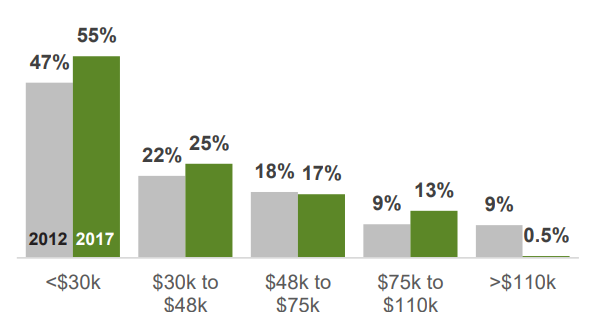 The top 10 fastest-growing jobs in Florida all require degrees and certificates beyond high school. In order for Florida to be talent-strong, students need a variety of affordable postsecondary options, whether that may be technical school, a two-year college, or four-year institution. The latest Southern Regional Education Board (SREB) college affordability profiles tell the story of affordability in each state. In several areas, including two-year and four-year institution affordability, Florida shines. However, for families in the lowest income bracket, the price of college can be cost-prohibitive.
The top 10 fastest-growing jobs in Florida all require degrees and certificates beyond high school. In order for Florida to be talent-strong, students need a variety of affordable postsecondary options, whether that may be technical school, a two-year college, or four-year institution. The latest Southern Regional Education Board (SREB) college affordability profiles tell the story of affordability in each state. In several areas, including two-year and four-year institution affordability, Florida shines. However, for families in the lowest income bracket, the price of college can be cost-prohibitive.
Florida’s affordability profile looks at the net price of education, which includes the total cost of attendance minus federal/state/institutional aid and scholarships. The report uses data from the 2017-18 academic year, the most recent year that student financial aid data are available. Even though this data represents a story of pre-pandemic affordability, it still has important takeaways.
In 2017-18, the percentage of family income required to pay for public higher education college in Florida was lower than the SREB average for all institution types except for technical institutions. In 2017, families in Florida needed, on average, 15% of their income to cover educational expenses at two-year institutions, and around 20% of their income to cover expenses at public four-year institutions. Not only did the amount of income needed to pay for public four-year and two-universities decrease since 2012-13, Florida is much lower than the average in other southern states.
Families in lower income brackets need a larger percentage of their income to pay for college, particularly at four-year institutions. For example, families making less than $30,000 needed 36% of their income to pay for four-year college in 2017. These families in particular benefit from financial aid and the decrease in net price at four-year institutions.
In most states, technical colleges are the most affordable route for families. Yet, according to SREB’s calculations, Florida’s technical institutions required a higher percentage of family income to pay for educational expenses in 2017 for most income categories. This is likely because there are different types of aid available for students attending technical college, compared to four or two-year institutions. Also striking, Florida families making less than $30,000 a year saw a larger increase in income needed to pay for technical college than wealthier income groups. Families in the lowest income bracket saw a jump from 47% of their income needed in 2012 to 55% of their income in 2017.
Regarding state financial aid, Florida awarded slightly more need-based aid in 2017-18 per full-time-equivalent student ($398) than the SREB average, and slightly less than the US average ($411). Additionally, Florida awards more merit-based aid ($580) than the SREB average ($476), and much more than the US average ($195). Both need-based aid and merit-based aid increased from 2012-13 to 2017-18.
When it comes to affordability and student borrowing, in 2017, Florida graduates borrowed less than the SREB and national averages to earn degrees at four-year and two-year institutions. Even though borrowing has substantially increased from 2012-2017, it is still lower than SREB and national averages. In Florida, 48% of the Class of 2019 graduated from four-year institutions with debt, owing an average of $24,629. This is slightly lower than the national average ($28,950), and Florida is in the top 10 for low-debt states — however, debt has increased 30% in the past 15 years.
The new profile shows that even though Florida leads in affordability, college costs are a great burden to families who make less than $30,000 a year. Because of this, financial aid is more important than ever as the price of college increases, students are borrowing more, and the economic impact of the COVID-19 pandemic continues to have far-reaching consequences. As of January 29, 2021, only a third of Florida’s high school class of 2021 had completed a FAFSA. Nationally, FAFSA completions are down, but Florida is currently below the national average, which paints a concerning picture for the state. Students who complete the FAFSA are 84% more likely to immediately enroll in postsecondary education.
Even in trying times, supporting Florida’s lowest income students along their journey to postsecondary access and success is essential. Floridians need education beyond high school to recover from disruptions like COVID-19 and prepare for the jobs of tomorrow. Florida’s best hope to build a resilient economy is for all Floridians to have education beyond high school. To see how your county is doing, see FCAN’s degree attainment profiles or visit the FAFSA Challenge Dashboard.
RELATED ARTICLES:

